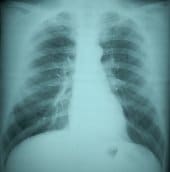Chest Radiography: Government Programs

Radiographic Classification: Government Programs
The information on this page refers to classification of chest radiographs that are made for certain federal programs that award disability benefits. A brief description of each of the major programs is given below; each has its own classification procedures and criteria.
Program Information
Federal Black Lung Benefits Program
Physicians performing medical testing for the Black Lung Benefits Program should follow regulations found in 20CFR718.102, 20CFR718.202, and 20CFR718 Appendix A. Further information on claims can be found under CFR Title 20, Chapter VI, Part 725. These regulations specify what medical testing must be done as well as the film and equipment that must be used for radiography. Chest radiographs must be classified using the International Labour Office (ILO) Classification System (ILO 2002). To find out about eligibility for Federal Black Lung Benefits, contact the nearest Black Lung Benefits Office.
The Energy Employees Occupational Illness Compensation Program
The Energy Employees Occupational Illness Compensation Program Act of 2000 provides compensation for silicosis limited to certain employees or eligible survivors of employees of the Department of Energy (DOE), its predecessor agencies, and its contractors and subcontractors who worked in tunnel mining for 250 days or more at certain DOE sites in Nevada or Alaska. Physicians should follow regulations regarding medical diagnosis of chronic silicosis for the Energy Employees Occupational Illness Compensation Program. A written diagnosis of silicosis must be made by a medical doctor and submitted along with a chest radiograph (classified by a B Reader), results of other imaging techniques, or a lung biopsy. The US Department of Labor (DOL)provides compensation determinations and all questions and diagnosis should be directed to DOL, not NIOSH, through the link above.
State Workers’ Compensation Programs
State workers’ compensation programs are completely separate from federal benefits programs. Some individuals may qualify for one program and not the other. State disability benefits and compensation differ by state, so contact the State Office of Workers’ Compensation to learn about compensation from the appropriate state governments. There are often time limits that apply to how long individuals have to make a claim after the worker is diagnosed with a compensable disease, so workers should be encouraged to avoid delay in contacting the relevant state office.
References
Standards for Determining Coal Miners’ Total Disability or Death Due to Pneumoconiosis. 20CFR718
Energy Employees Occupational Illness Compensation Program Act of 2000, as described on the US Department of Labor compliance assistance web site.
State Workers’ Compensation Officials. US Department of Labor
